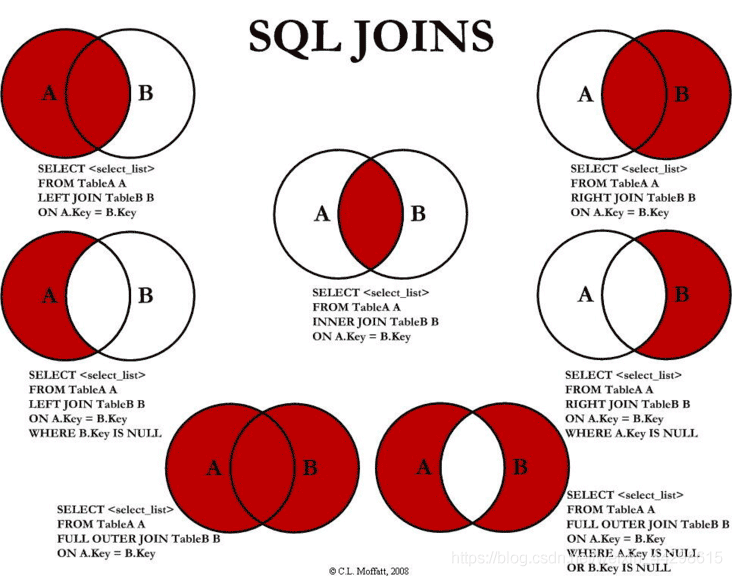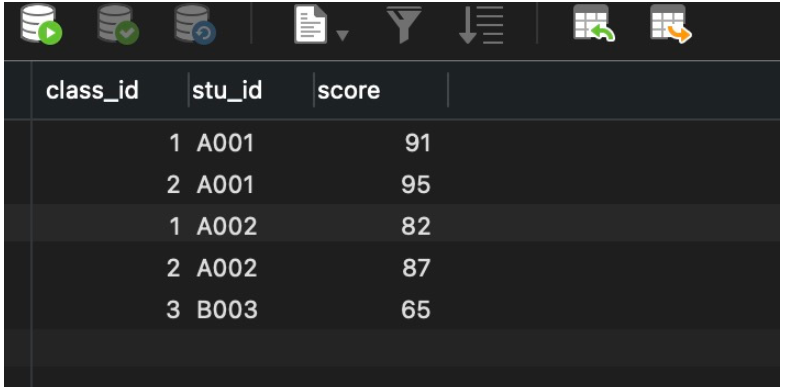 Database
Database
 Mysql Tutorial
Mysql Tutorial
 The basic usage of mysql left join and the difference between on and where
The basic usage of mysql left join and the difference between on and where
The basic usage of mysql left join and the difference between on and where
Preface
When we write SQL statements, we cannot avoid using connection keywords, such as inner connections and outer connections. There are many types. I will post here a picture I found elsewhere:

I think this picture is very detailed. It shows the SQL statements. Common link types, taking left join in this article as an example, are defined online as follows: The LEFT JOIN keyword will return all rows from the left table, even if there are no matching rows in the right table.
In fact, just from the literal meaning, left join is relatively easy to understand, but in the process of using it, there will still be some problems, such as the condition after on and after After where, their results are completely different. Next, we will learn about left join from shallow to deep.
Example
1 2 3 4 5 6 |
|
score table:
1 2 3 4 5 |
|
They each have data:


Q1: select c.class_id,c.class_name,c.class_grade,s.stu_id,s.score from class c left join score s on c.class_id=s.class_id.
This sentence can be rewritten as: We analyzed this statement. The left table is the class table, the right table is the score table, and their associated field is class_id. When the class_id in the left table is 1, there are two records in the right table with class_id 1; when the class_id in the left table is 2, the class_id in the two records in the right table is 2; when the class_id in the left table is 3, there is one record in the right table The class_id of the record is 3, so we should get five records:
1 2 3 4 5 |
|
Q2: select c.class_id,c.class_name,c.class_grade,s.stu_id,s.score from class c left join score s on c.class_id=s.class_id and s.score=90.
Based on the example of the first question, this one has an additional condition of s.score=90. This means that the score field of the right table score is 90, but when we look at the data in the table, we find that there is no score of 90 in the right table. , ok, will the result be empty? After all, the table on the right does not have data that meets the conditions.
In fact, if you execute this SQL statement, you will eventually get the result, but you will only get three pieces of data. All fields in the left table are displayed, and all fields in the right table are empty. This is because there is no record in the right table with a score of 90, so the fields in the right table are empty.
on filters the data first and then connects it, while where filters the data after performing a related query between the two tables. The difference between on and where is here, and will be covered in subsequent examples. These two are different.
1 2 3 |
|
Q3: select c.class_id,c.class_name,c.class_grade,s.stu_id,s.score from class c left join score s on c.class_id=s.class_id where c.class_name=&lsquo ;Chinese’ and s.score=90.
You need to pay attention to the difference between where and on, because this statement involves the where keyword. The query result of this sql is empty. This is because the two tables are connected to query the results first, and then filtered. The result of the query of the connected table is that there is no record matching class_name=‘中文’, and score=90, so The query result is empty.
Q4: select c.class_id,c.class_name,c.class_grade,s.stu_id,s.score from class c left join score s on c.class_id=s.class_id and 1=0.
We sometimes add 1=1 after the where condition of SQL, and 1=0 here means that the association between the two tables has failed, so the result will only display the data from the left table.
1 2 3 |
|
Q5: select c.class_id,c.class_name,c.class_grade,s.stu_id,s.score from class c left join score s on 1=0.
The execution result of this is the same as the above SQL statement. In fact, all the contents of the left table are displayed.
1 2 3 |
|
Q6: select c.class_id,c.class_name,c.class_grade,s.stu_id,s.score from class c left join score s on c.class_id=s.class_id and c.class_name=&lsquo "Chinese".
This requires filtering out the records with class_name as language in the right table, there are two, and then connecting the two records in the left table, so it is not difficult to see that there are four results:
1 2 3 4 |
|
Q7: select c.class_id,c.class_name,c.class_grade,s.stu_id,s.score from class c left join score s on c.class_id=s.class_id and c.class_name=‘English’.
Analyze the same question as the previous one (the result in the blank area is null):
1 2 3 |
|
Q8: select c.class_id,c.class_name,c.class_grade,s.stu_id,s.score from class c left join score s on c.class_id=s.class_id and c.class_name=‘体育’.
There is no data in the right table and the class_name is sports, so the right table is empty. All data in the left table is displayed. The corresponding fields in the right table are empty:
1 2 3 |
|
Q9: select c .class_id,c.class_name,c.class_grade,s.stu_id,s.score from class c left join score s on c.class_id=s.class_id and c.class_name=‘中文’ and s.score=91.
右表中只有一条记录的score为91,所以需要拿左表与右表的这一条数据进行关联,左表只有语文可以与右表的那一条数据对上,所以结果为:
1 2 3 |
|
Q10:select c.class_id,c.class_name,c.class_grade,s.stu_id,s.score from class c left join score s on c.class_id=s.class_id and c.class_name=‘体育’ and s.score=90。
右表中没有数据的score为90,同样左表中也没有class_name为体育,但是这并不意味着最后的结果就是空了,只要没有where条件,最终的结果数量最起码也会是左表中原先的数据数量,所以这条sql会返回左表的全部数据。
1 2 3 |
|
Q11:select c.class_id,c.class_name,c.class_grade,s.stu_id,s.score from class c left join score s on c.class_id=s.class_id where c.class_name=‘英语’。
需要注意的点:条件是在where中的,也就是在表关联之后,再进行过滤的,所以最终的结果只会有一条:
1 |
|
Q12:select c.class_id,c.class_name,c.class_grade,s.stu_id,s.score from class c left join score s on c.class_id=s.class_id where s.score=91。
和上面一样,是在连表查询之后,找出score=90的数据:
1 |
|
Q12;select c.class_id,c.class_name,c.class_grade,s.stu_id,s.score from class c left join score s on c.class_id=s.class_id where c.class_name=‘语文’ and s.score=91。
我们将两表连接查询后,找出结果中class_name为语文,score为91的记录,只有一条:
1 |
|
The above is the detailed content of The basic usage of mysql left join and the difference between on and where. For more information, please follow other related articles on the PHP Chinese website!

Hot AI Tools

Undresser.AI Undress
AI-powered app for creating realistic nude photos

AI Clothes Remover
Online AI tool for removing clothes from photos.

Undress AI Tool
Undress images for free

Clothoff.io
AI clothes remover

AI Hentai Generator
Generate AI Hentai for free.

Hot Article

Hot Tools

Notepad++7.3.1
Easy-to-use and free code editor

SublimeText3 Chinese version
Chinese version, very easy to use

Zend Studio 13.0.1
Powerful PHP integrated development environment

Dreamweaver CS6
Visual web development tools

SublimeText3 Mac version
God-level code editing software (SublimeText3)

Hot Topics
 1378
1378
 52
52
 MySQL: Simple Concepts for Easy Learning
Apr 10, 2025 am 09:29 AM
MySQL: Simple Concepts for Easy Learning
Apr 10, 2025 am 09:29 AM
MySQL is an open source relational database management system. 1) Create database and tables: Use the CREATEDATABASE and CREATETABLE commands. 2) Basic operations: INSERT, UPDATE, DELETE and SELECT. 3) Advanced operations: JOIN, subquery and transaction processing. 4) Debugging skills: Check syntax, data type and permissions. 5) Optimization suggestions: Use indexes, avoid SELECT* and use transactions.
 How to create navicat premium
Apr 09, 2025 am 07:09 AM
How to create navicat premium
Apr 09, 2025 am 07:09 AM
Create a database using Navicat Premium: Connect to the database server and enter the connection parameters. Right-click on the server and select Create Database. Enter the name of the new database and the specified character set and collation. Connect to the new database and create the table in the Object Browser. Right-click on the table and select Insert Data to insert the data.
 How to open phpmyadmin
Apr 10, 2025 pm 10:51 PM
How to open phpmyadmin
Apr 10, 2025 pm 10:51 PM
You can open phpMyAdmin through the following steps: 1. Log in to the website control panel; 2. Find and click the phpMyAdmin icon; 3. Enter MySQL credentials; 4. Click "Login".
 MySQL and SQL: Essential Skills for Developers
Apr 10, 2025 am 09:30 AM
MySQL and SQL: Essential Skills for Developers
Apr 10, 2025 am 09:30 AM
MySQL and SQL are essential skills for developers. 1.MySQL is an open source relational database management system, and SQL is the standard language used to manage and operate databases. 2.MySQL supports multiple storage engines through efficient data storage and retrieval functions, and SQL completes complex data operations through simple statements. 3. Examples of usage include basic queries and advanced queries, such as filtering and sorting by condition. 4. Common errors include syntax errors and performance issues, which can be optimized by checking SQL statements and using EXPLAIN commands. 5. Performance optimization techniques include using indexes, avoiding full table scanning, optimizing JOIN operations and improving code readability.
 How to create a new connection to mysql in navicat
Apr 09, 2025 am 07:21 AM
How to create a new connection to mysql in navicat
Apr 09, 2025 am 07:21 AM
You can create a new MySQL connection in Navicat by following the steps: Open the application and select New Connection (Ctrl N). Select "MySQL" as the connection type. Enter the hostname/IP address, port, username, and password. (Optional) Configure advanced options. Save the connection and enter the connection name.
 How to recover data after SQL deletes rows
Apr 09, 2025 pm 12:21 PM
How to recover data after SQL deletes rows
Apr 09, 2025 pm 12:21 PM
Recovering deleted rows directly from the database is usually impossible unless there is a backup or transaction rollback mechanism. Key point: Transaction rollback: Execute ROLLBACK before the transaction is committed to recover data. Backup: Regular backup of the database can be used to quickly restore data. Database snapshot: You can create a read-only copy of the database and restore the data after the data is deleted accidentally. Use DELETE statement with caution: Check the conditions carefully to avoid accidentally deleting data. Use the WHERE clause: explicitly specify the data to be deleted. Use the test environment: Test before performing a DELETE operation.
 How to use single threaded redis
Apr 10, 2025 pm 07:12 PM
How to use single threaded redis
Apr 10, 2025 pm 07:12 PM
Redis uses a single threaded architecture to provide high performance, simplicity, and consistency. It utilizes I/O multiplexing, event loops, non-blocking I/O, and shared memory to improve concurrency, but with limitations of concurrency limitations, single point of failure, and unsuitable for write-intensive workloads.
 MySQL: An Introduction to the World's Most Popular Database
Apr 12, 2025 am 12:18 AM
MySQL: An Introduction to the World's Most Popular Database
Apr 12, 2025 am 12:18 AM
MySQL is an open source relational database management system, mainly used to store and retrieve data quickly and reliably. Its working principle includes client requests, query resolution, execution of queries and return results. Examples of usage include creating tables, inserting and querying data, and advanced features such as JOIN operations. Common errors involve SQL syntax, data types, and permissions, and optimization suggestions include the use of indexes, optimized queries, and partitioning of tables.



